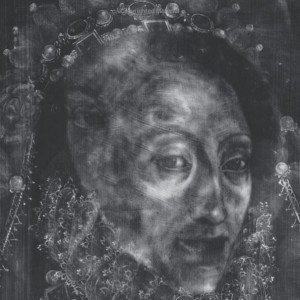Tag-Archive for » portrait «
 Już od jakiegoś czasu przygotowywałam dla Was artykuł na temat portretu Anny Boleyn. Tym razem przedmiotem badań jest portret Elżbiety Tudor, który powstał przypuszczalnie w latach 1580-1590. Badania wykazały, że pod twarzą królowej Elżbiety, znajduje się twarz inne kobiety. Portret został poddany specjalistycznym badaniom (w tym w podczerwieni) które odkryły twarz nieznanej kobiety ukrytej pod portretem Elżbiety Tudor.
Już od jakiegoś czasu przygotowywałam dla Was artykuł na temat portretu Anny Boleyn. Tym razem przedmiotem badań jest portret Elżbiety Tudor, który powstał przypuszczalnie w latach 1580-1590. Badania wykazały, że pod twarzą królowej Elżbiety, znajduje się twarz inne kobiety. Portret został poddany specjalistycznym badaniom (w tym w podczerwieni) które odkryły twarz nieznanej kobiety ukrytej pod portretem Elżbiety Tudor.
Można zauważyć, że twarz nieznanej kobiety jest zwrócona w przeciwnym kierunku niż twarz Elżbiety. Badania z National Portrait Gallery ukazują, że nieznana kobieta ma na sobie Francuskie nakrycie głowy, którego kształt datuje powstanie portretu na lata 70 lub 80 XVI wieku.
Mnie osobiście twarz kobiety bardzo przypomina twarz Anny Boleyn z portretu z National Portrait Gallery oraz Hever. Łatwo można zauważyć owalną twarz, duże ciemne oczy, pełne usta oraz wysokie kości policzkowe. Nie da się także nie zauważyć podobieństwa pomiędzy wizerunkiem nieznanej kobiey, a wieloma portretami Elżbiety Tudor. Czy więc pod portretem Elżbiety skrywa się portret jej matki? Dlaczego królowa miałaby ukrywać portret Anny pod własnym wizerunkiem? Istnieje kilka możliwych wyjaśnień ;
Today I want to discuss about ‘Portraith with a serpent’ that depicts Queen Elizabeth Tudor. Underneath Elizabeth’s face there is a portrait of unknown woman. She is facing opposite direction and in a higher position than the queen. According to National Portrait Gallery, :
”The X-ray shows a female head in a higher position, facing in the opposite direction to the portrait of Elizabeth. The eyes and nose of the face underneath can now be seen where paint has been lost from Elizabeth’s forehead. The lips and headdress can also be seen, as can the ruff which was positioned underneath Elizabeth’s chin. The identity of the original sitter remains a mystery but the unfinished portrait appears to have been very competently painted, probably by a different artist. The original sitter appears to have been wearing a French hood of a type that was fashionable in the 1570s and 1580s, suggesting that there may have been a period of a few years before the panel was re-used.”
If you look closely, you can notice the similarity between unknown woman and … Anne Boleyn! The oval face with dark dramatic eyes, high cheekbones and full lips bears resemblance to contemporary accounts on Anne Boleyn’s appearance. This portrait looks very similar to NPG and Hever portraits of Anne Boleyn.
W swojej najnowszej książce ‘Mary Boleyn: The Great and Infamous Whore’ Alison Weir napisała, że słynny portret Marii Boleyn może nie być portretem Marii, lecz Frances Brandon, matki Joanny Grey.
Na swojej stronie internetowej[1], Alison Weir wyjaśnia swoją tezę ;
- sześć istniejących wersji portretu wskazuje że osoba na nim przedstawiona musiała być ważna na dworze :
- kobieta przyodziana jest w futro z gronostaja, zarezerwowane dla klasy wyższej i rodziny królewskiej : w połączeniu z wieloma kopiami portretu, można wynsuć wniosek iż kobieta pochodziła z rodziny królewskiej ;
- kostium pochodzi z lat 30 XVI wieku ; jak wiadomo Maria Boleyn została wygnana z dworu w 1534 r. i Alison Weir argumentuje, że nie była ważną osobistością, w związku z czym nie było potrzeby aby namalować jej portret.
- możliwe że portret powstał przy okazji ślubu Frances Brandon w 1533 r., ale tutaj z kolei pojawia się kolejny problem – Frances również nie była aż tak ważną osobą aby powielać jej portret aż 6 razy.
Przypomnę Wam kim była Frances Brandon – córką Marii Tudor Brandon z małżeństwa z Księciem Suffolk Karolem Brandonem. Frances była matką ‘dziewięciodniowej królowej’ Joanny Grey ściętej za zdradę stanu poprzez bezprawne przejęcie tronu.
In her latest book ‘Mary Boleyn: The Great and Infamous Whore’ Alison Weir points out that the famous portrait of Mary Boleyn may actually be a portrait of Frances Brandon, mother of Jane Grey. On her website, Alison Weir gives an explanation of this theory :
‘I’ve written a whole appendix on the subject of portraits of Mary Boleyn and William Carey. The fact that there are at least six versions of the ‘Mary’ portrait indicates that there was demand for a portrait of the sitter, and she is wearing ermine, a fur restricted to the upper nobility and royalty. So I suspect, given the proliferation of the image, that the sitter was royal. Anyway, the costume is that of the mid-1530s. There would not have been any demand for Mary at that time, given that she was little known and in disgrace (and probably living abroad) from 1534. The sitter bears no resemblance to portraits of Anne Boleyn, Jane Seymour or Margaret Douglas. She is too young to be Mary Tudor, who died in 1533. Could this be Frances Brandon? A wedding portrait from 1533? There is a resemblance in the nose to Charles Brandon in his ‘marriage’ portrait (yes, I think it is him, having done some digging last night, although I think it’s later than 1515/16.) Even so, that doesn’t quite explain the demand for pictures of Frances – she wasn’t that well known either! It would help if we could identify any clue or reference in the pendant or brooch, or the flowers, but they are too indistinct.‘[1]
For a very long I’ve been thinking about Mary Boleyn portrait, and something was not right. I agree with Alison Weir in few points :


 Polish
Polish English
English




